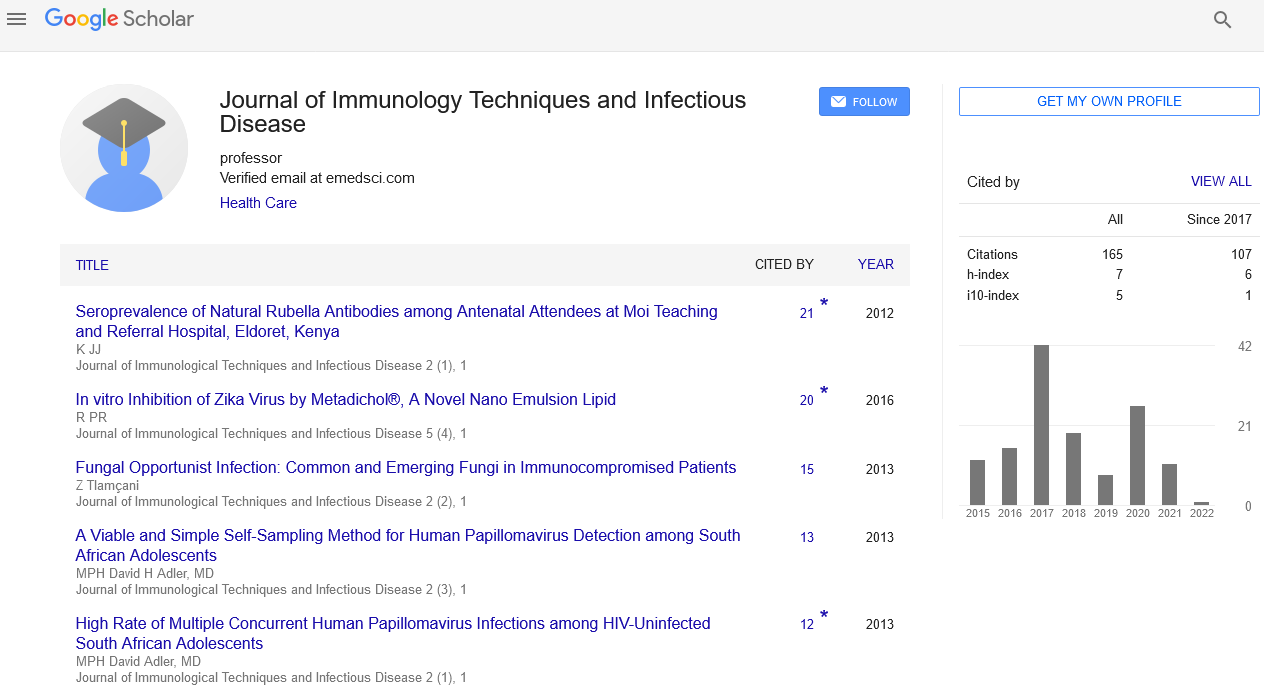Opinion Article, J Immunol Tech Infect Dis Vol: 13 Issue: 3
Airborne Pathogens and Public Health: Risks, Transmission and Economic Consequences
Nabila Yassine*
1Department of Immunology, University Hospital Mohammed VI of Marrakech, Marrakech, Morocco
*Corresponding Author: Nabila Yassine,
Department of Immunology, University
Hospital Mohammed VI of Marrakech, Marrakech, Morocco
E-mail: yassinenabila@gmail.com
Received date: 26 August, 2024, Manuscript No. JIDIT-24-151948;
Editor assigned date: 28 August, 2024, PreQC No. JIDIT-24-151948 (PQ);
Reviewed date: 11 September, 2024, QC No. JIDIT-24-151948;
Revised date: 18 September, 2024, Manuscript No. JIDIT-24-151948 (R);
Published date: 25 September, 2024, DOI: 10.4172/2329-9541.1000389
Citation: Yassine N (2024) Airborne Pathogens and Public Health: Risks, Transmission and Economic Consequences. J Immunol Tech Infect Dis 13:3.
Description
Airborne diseases, caused by pathogens that spread through the air, are a major public health concern. Similar to diseases that require close contact for transmission, airborne diseases spread through microscopic droplets or particles that can remain in the air, increasing the risk of widespread outbreaks, especially in strongly populated areas. These diseases range from the common cold and flu to severe illnesses including tuberculosis, measles and COVID-19.
Airborne diseases are caused by bacteria, viruses or fungi that can travel through the air, usually through respiratory droplets or aerosolized particles. When an infected person coughs, sneezes, talks or even breathes, they release tiny droplets that contain pathogens. These droplets can be inhaled by people nearby, leading to infection. Some airborne pathogens can survive on surfaces for extended periods.
How airborne diseases are spread?
The transmission of airborne diseases involves the release and inhalation of infectious droplets or aerosols. There are three main ways airborne diseases spread.
Droplet transmission: When a person coughs, sneezes or talks, they release droplets that contain pathogens. These droplets can travel short distances and people living surrounding can breathe, causing infection. Droplet transmission is common for diseases including the flu and COVID-19.
Aerosol transmission: Smaller than droplets, aerosols are tiny particles that can remain suspended in the air for extended periods.
They are inhaled more easily than larger droplets, which allow them to spread over greater distances. Aerosol transmission is significant for diseases such as tuberculosis and measles, these diseases are very infectious
Surface contamination: Some pathogens that cause airborne diseases can survive on surfaces, meaning people can touch a contaminated surface and then their mouth, nose or eyes, potentially leading to infection. This transmission route, although indirect, plays a significant role in diseases such as influenza and COVID-19.
Impact of airborne diseases on public health
Airborne diseases have significant implications for public health, healthcare systems and global economies. Their rapid spread, potential for high morbidity and socioeconomic impact make them a major concern for health authorities worldwide.
Healthcare burden: Airborne diseases lead to high hospitalization rates, especially during outbreaks. Diseases such as influenza and COVID-19 place a substantial strain on healthcare facilities, leading to bed shortages, increased medical costs and stress on healthcare providers. The COVID-19 pandemic, revealed vulnerabilities in healthcare infrastructure and the need for robust public health systems.
Morbidity and mortality: Airborne diseases remain a major cause of illness and death, particularly among vulnerable populations. For instance, tuberculosis remains one of the top causes of death from infectious diseases, especially in low-and middle-income countries. Annual influenza outbreaks lead to significant deaths and complications, especially in the elderly and those with established health conditions.
Economic impact: Outbreaks of airborne diseases can disrupt economies by reducing workforce productivity, limiting travel and increasing healthcare costs. The COVID-19 pandemic illustrated the economic impact that airborne infections may have, as organizations closed, supply systems failed and employment rates reached globally. Public health measures such as lockdowns and restrictions, while necessary, further impacted economies and highlighted the connections of health and economic stability.
Social and psychological impact: The isolation measures needed to control airborne diseases, especially during pandemics, can lead to social and mental health challenges. Prolonged isolation, fear of infection and depression for the sudden death contribute to anxiety and other mental health issues. Communities are also impacted by stigma and discrimination associated with infectious diseases, leading to additional social challenges.
 Spanish
Spanish  Chinese
Chinese  Russian
Russian  German
German  French
French  Japanese
Japanese  Portuguese
Portuguese  Hindi
Hindi 
